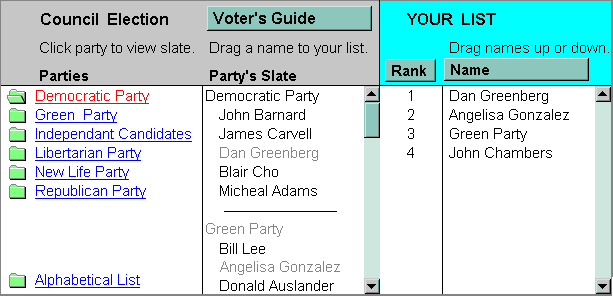|
Different uses for voting
need different types of voting. |
 |
Preference Ballots |
 |

ChoicesOld-fashioned ballots oversimplify most questions. They let you mark only one option “yes”, leaving all others “no”. Such ballots leave voters with very little choice.This kind of ballot misses many gradations and subtleties in opinions or priorities. It promotes false dichotomies, limited choices that polarize voters and increase conflict. Preference ballots minimize those negative traits and results. They let you rank your first choice, second choice, third, and so on. Voters rank as many as they care to — but more complete ballots may be more effective. Tied ranks are sometimes allowed. Preference ballots reveal that the old political dichotomies of “us versus them” or left versus right, hide many subtle shades of opinion.Consider a three-way race. A plurality ballot would produce just 3 factions, each supporting 1 candidate. But a preference ballot would reveal 6 preference orders for Al, Bob, and Cy: (1st, 2nd, 3rd) (1, 3, 2) (2, 1, 3) (2, 3, 1) (3, 1, 2) and (3, 2, 1). Tie votes add (1, 1, 1) (1, 1, 3) (1, 3, 1) (3, 1, 1). Such differences do affect who wins by the Condorcet, LER and STV rules. So black and white differences meld into grays, then hues of some color. More candidates add more colors. Four candidates give 24 preference orders, 6 give 720, and 8 give 40,320. |

A Voter’s Task, easy as 1, 2, 3First choice, second choice, and so on are all voters have to think about to vote effectively. They can forget manipulations and strategies. The ease of voting preferences is shown by very high rates of voter participation, often about 90% compared with 50% for many plurality-rule elections.The Counter’s TaskSome people have thought that preference ballots and their tally rules make ballot counting too hard. But that fear should no longer block the progress of democracy. Today, the most time-consuming tallies are made easy by small computers and easy-to-use software. |

_________________________________
Preference Ballot ties allowed
. Rank
Best Worst
Name 1st 2 3 4 5 6th
Dole O O O O O O
Perot O O O O O O
Clinton O O O O O O
? ? ? O O O O O O
Ballot DesignsBallot Position Advantage Some voters tend to pick the first item on a list. The second item listed also gets some indiscriminate votes. Every item should get a share of these arbitrary votes. So list each item in the first position on a fair share of ballots. If the names must be easy to find, the list can be alphabetical for half the voters and reversed for the others.Some voters think a 9 is better than a 1. Using ABC's may help them avoid that error. Large elections can use machine- scored “bubble forms” like these. Most voters know such forms from multiple-choice tests in school. Try clicking on the top ballot. “Ballot stock is considered a controlled document. This is one of the really nice things about physical ballots: at the end of the election, you should have the same number of ballots as you started with: some voted, some spoiled, and the rest unused.” Erik Nilsson of Computer Professionals for Social Responsibility. |


|
Click on a party to view its slate of candidates. Drag a name from the party's slate to your list. Drag a name up or down your list to change its rank. If you rank a party, that rank is given to all of its candidates who are not on your list. An on-line ballot for finding and ranking favorite candidates in a large field. |
This ballot borrows from two widely-known user interfaces: web page frames and the Windows Explorer or Mac Finder.
The left-hand column “Parties” is a frame for party folders. (Party symbols may replace the generic folders shown.) This list stays in view always; but clicking a party's name moves the middle list of candidates to that party's slate.
The middle and right columns, “Party's Slate” and “Your List”, let voters drag names between columns like dragging files between desktop folders. Voters may drag names up and down the right-hand column as easily as rearranging bookmarks in a web browser's list.
Twin Oaks uses a ballot like this for funding projects. |

There is wide-spread concern among voters about the danger of fraud by the privately-held corporations whose secret software runs electronic voting booths and vote-counting computers.
In the safest method, a voter enters choices on a touch screen, then prints out the ballot with his votes and serial number. He checks it, then puts it in the ballot box. Unlike most paper ballots, this one cannot be altered by anyone with a pencil. Touch screens with paper printouts are now available.
Later, the Logic and Accuracy tests by local election officials compare a sample of paper ballots against the computer data sent by the touch screens to the vote- counting software. Finally, that tally software must be “open source” so anyone who can read the programming language may inspect the code.
The Tools page lists sites with preference ballots for online voting and open- source software to tally many voting rules.
|
| |||||
|---|---|---|---|---|---|
| Electoral Systems | Legislative Systems | ||||
Reps
| Council
Condorcet chair plus PR reps | Policy

Condorcet and rules of order | Projects
| Budgets
| |

|
|


 Accurate Democracy
Accurate Democracy 


